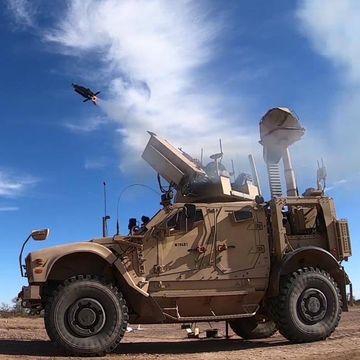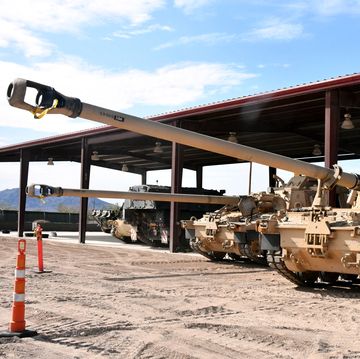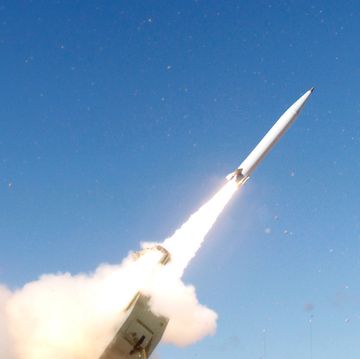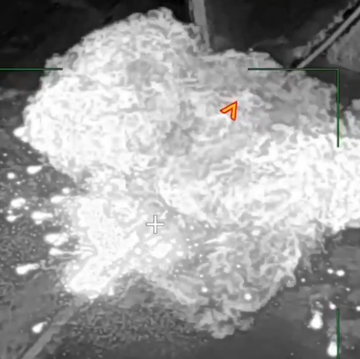Following a recent 10-day naval exercise and threats to shut down shipping traffic in the Strait of Hormuz, an enormously important shipping lane for petroleum, Iran once again upped the ante in its standoff with the U.S. this week. The nation threatened to retaliate if the United States sends its aircraft carrier, the USS John C. Stennis, back to the Persian Gulf.
While the United States has already rejected Iran's demands, the U.S. government is also saying it doesn't want an all-out military conflict in the region. "No one in this government seeks confrontation over the Strait of Hormuz," Pentagon spokesman George Little said Tuesday. "It's important to lower the temperature."
But if the United States military does face off with Iran in the Strait of Hormuz, what would such a conflict look like? One thing is certain, according to military analysts: It would probably look very different than when the U.S. and Iran fought here in the late 1980s. That was when the United States launched Operation Praying Mantis, a military attack against Iranian assets in the Gulf to retaliate for an Iranian mine that blew a hole in a U.S. frigate.
The naval conflict—the largest U.S. naval engagement since World War II—pitted Iran's surface ships and fighters against U.S. military forces in a head-to-head conflict. Iran suffered significant losses, while U.S. casualties were light. Michael Rubin, a resident scholar at the American Enterprise Institute in Washington, D.C., says that battle 20-plus years ago changed Iran's strategy from then on.
"After this, Iran decided they weren't going to compete head-on [with the United States]," Rubin says, "They were going to try to get at us asymmetrically." Asymmetric attacks are not intended to defeat the United States with superior technology, but to inflict enough damage to raise the stakes for U.S. involvement in the region. That means employing tactics and weapons that seek to maximize damage against U.S. forces at relatively low cost for Iran, according to Michael Connell, director of the Iranian Studies Program at the Center for Naval Analyses.
"The mine threat is what everybody is most excited about," Connell says, "But they also have anti-ship cruise missiles, small boats, and they have submarines."
Indeed, in a 2008 report published by the Washington Institute for Near East Policy, Fariborz Haghshenass, an Iranian military expert, described a myriad of technologies that Iran could use in a conflict with U.S. forces. "Iran could launch a coordinated attack involving explosives-laden remote-controlled boats, swarming speedboats, semisubmersible torpedo boats, fast attack craft (FACs), kamikaze UAVs, midget and attack submarines, and shore-based anti-ship missile and artillery fire, all concentrated on a U.S.-escorted convoy or surface action group transiting the Strait of Hormuz," Haghshenass wrote.
The threat is enhanced by the fact that Iran essentially has two navies. The standard surface fleet doesn't pose much of a threat to U.S. military ships, and would very likely be destroyed in the early days of any conflict: "Its capabilities are not that sophisticated," Connell says. But Iran also has naval forces operated by the Iranian Revolutionary Guard Corps (IRGC), which has been expanding its role in recent years and investing in technologies like the speedboats that could be used for suicide attacks.
In addition, Iran has been bulking up on anti-ship missiles. According to the Center for Strategic and International Studies, the IRGC operates patrol boats with C-802 guided anti-ship missiles. It also has H-2 Seersucker land-based anti-ship missiles. Those missiles may not be better than what the United States has, but it may not matter—the Iranians have geography on their side. The Strait of Hormuz is shallow and narrow, which renders some measures of traditional military power moot.
"When you have only 150 feet of sea if you will, it makes it hard to maneuver," Rubin says. "It undercuts our advantage."
That's ultimately what makes the potential for a conflict in the Strait of Hormuz so unsettling: The U.S. military's ability to undermine an Iranian blockade rests on its ability to deploy overwhelming force, but that same force makes it vulnerable to Iran's asymmetric attacks.
Michael Eisenstadt, a senior fellow at the Washington Institute for Near East Policy, says the scary scenario is one in which an Iranian provocation escalates out of control, leading to a large-scale conflict in the Persian Gulf. If that happens, Iran might attack U.S. naval forces from a number of directions, including air and sea, and some attacks might well penetrate U.S. defenses.
"We'll win in the end, at the end of the day, and the Iranian navy will be at the bottom of the Persian Gulf," Eisenstadt says. "But we could suffer unexpected losses."













